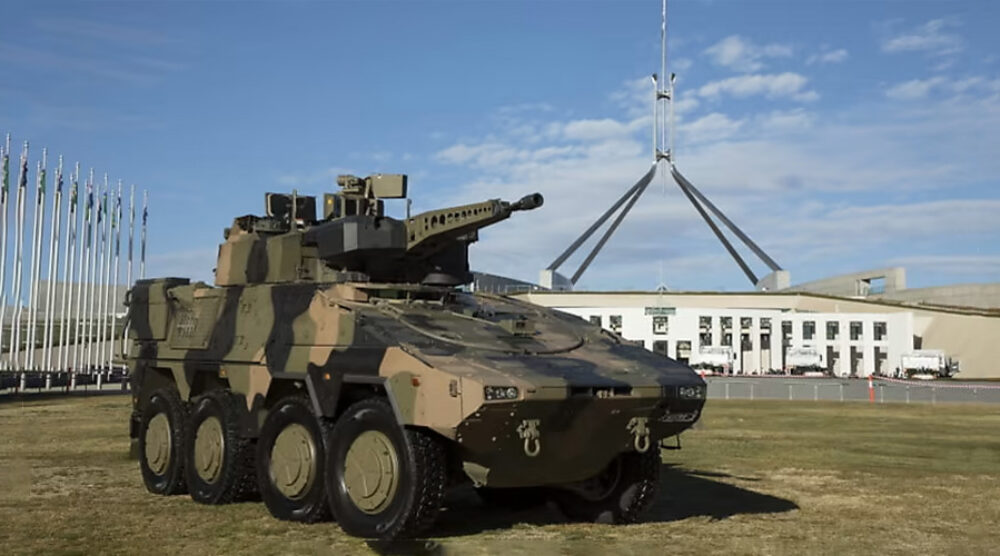Early last year, German Chancellor Olaf Scholz declared Russia’s invasion of Ukraine a major historical turning point—a zeitenwende.
That turning point continues to play out. On the eve of this week’s NATO summit in Lithuania, Berlin and Canberra announced a deal that will send more than 100 Boxer armoured fighting vehicles from Australia to Germany—not the other way around, as had been the case when Australia bought about 100 Leopard tanks in the mid-1970s.
This unique deal, worth more than A$1 billion, is driven by the demands for a rapid German rearmament after the strategic shock of Russia’s invasion of Ukraine. Germany doesn’t have adequate military production capacity to meet its suddenly pressing new defence needs.
Prime Minister Anthony Albanese then added to the German deal by declaring an Australian Air Force Boeing E-7A Wedgetail surveillance aircraft would be based at Ramstein Air Force Base in Germany for six months, starting in October.
This aircraft will be part of NATO surveillance of the alliance’s eastern flank, in particular European logistical hubs supporting Ukraine. These could be threatened by air incursions from Russia or Belarus if the war escalates.
The Wedgetail will be able to detect aircraft approaching the Baltic states or Poland in the east. It can then determine their likely intent and whether they are friendly or not. Then, if necessary, an airborne air defence fighter aircraft could be vectored to intercept the intruder.
This task has been carried out by NATO’s E-3 AWACS aircraft, but these planes were bought in the 1980s and have very low reliability. The Wedgetail is only a decade or so old and is much easier to maintain and keep in the air.
With this move, Australia will now share the burden of continual air patrols in Eastern Europe made necessary by the Russian invasion.
Bringing Germany and Australia closer together
The Boxer is an eight-wheeled armoured vehicle fitted with a 30-millimetre automatic cannon. It is operated by a crew of three and able to carry eight solders in its rear cabin.
The Boxers are built at a facility just outside Brisbane. In late 2018, the German arms manufacturer Rheinmetall won a $4.28 billion contract to build 211 Boxer Combat Reconnaissance Vehicles for the Australian Army. As part of the contract, the Australian government mandated Rheinmetall build the majority of the vehicles in Australia.
The new Boxers being built for Germany will be based on the Australian Army’s reconnaissance vehicle design, but given a different name: “heavy weapon carrier infantry”. The first deliveries will be made in 2025.
The Boxer deal helps to bring Germany and Australia closer at a time when Berlin is increasingly interested in Indo-Pacific defence matters.
In 2021, a German warship visited the northern Indian Ocean and western Pacific in a long deployment, and the following year, the German air force joined in an air defence exercise in Darwin.
In late June, Germany released its first National Security Strategy, which called China a “partner, competitor and systemic rival” and observed that competition with China has “increased in the past years”.
And later this month, Germany will send more than 200 soldiers to participate in the Talisman Sabre, a large, multinational, military exercise in eastern Australia. It will be the first time Germany participates in the drills.
Why the deal matters to both countries
The Boxer deal is also appealing domestically to both leaders.
For Scholz, buying vehicles from the factory of a German arms manufacturer in Australia is more attractive than buying US-made arms. Moreover, the deal would seem pivotal in ensuring Rheinmetall Defence Australia is now chosen over South Korea’s Hanwha to build 129 new Infantry Fighting Vehicles for the Australian Defence Force (ADF).
For Albanese, the Boxer deal is one of Australia’s largest defence export orders ever, which will create hundreds of jobs.
It will also ameliorate some dissatisfaction in the defence industry over the recent Defence Strategic Review. Of note, the review saw no place for vehicles like the Boxer in the Australian Defence Force of the future, and certainly not in local production.
However, the deal will have some direct effects on the defence force in the short term. Fulfilling the German order will probably delay Boxer deliveries to the ADF at a time when quickly increasing its capabilities is considered important.
Moreover, sending a surveillance aircraft to Europe will take it away from Australia’s area of principal strategic interest. However, the Ramstein air base is a very large American facility, so this move will also help support the burgeoning Australia-US military alliance.
Australia was Boeing’s first customer for the Wedgetail aircraft in the early 2000s. Some will hope NATO will now look favourably at also buying them from the US. This could help lower the overall operating costs of the fleet. Larger fleets gain economies of scale and reduce individual maintenance costs.
Could more deals be forthcoming?
These deals were announced even before the NATO summit, so could there be more to come?
Australia is reportedly in negotiations to potentially give up to 41 old Hornet fighter jets to Ukraine. Ukraine is apparently interested in the retired jets, if perhaps only to spur others into gifting it a much larger number of F-16s.
This is all somewhat missing the forest for the trees, however. Russia’s war has now dragged on past the 500-day mark. It is reasonable to assume Ukraine will need more support from NATO and its allies. And as the war drags on, it is diverting attention away from the Indo-Pacific, where Australia’s core geostrategic focus lies.
But Australia will remain on the hook for more aid until the war ends. Boxers and Wedgetails are fine in their own way, but the main game remains defeating Russia and driving it out of Ukraine. With that, the historical turning point would be complete.
AUTHOR
Dr Peter Layton is Visiting Fellow at the Griffith Asia Institute. This article was first published at The Conversation.








